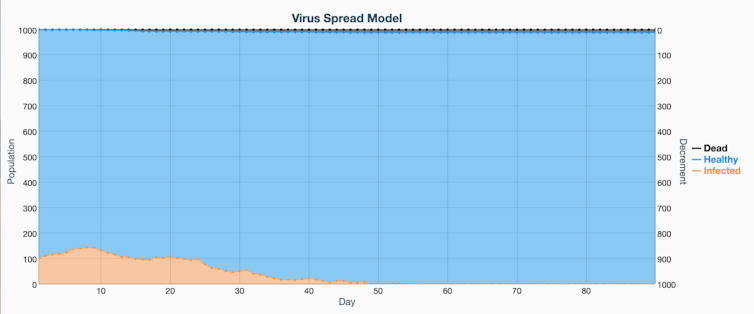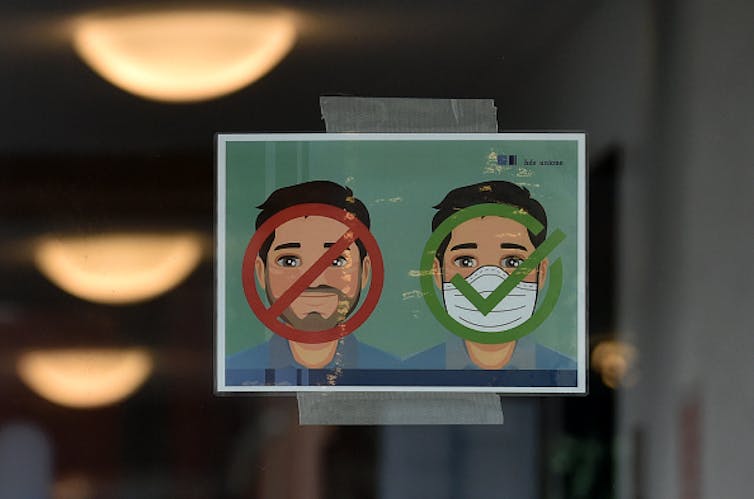This simple model shows the importance of wearing masks and social distancing
- Written by Jeyaraj Vadiveloo, Director of the Janet and Mark L. Goldenson Center for Actuarial Research, University of Connecticut
The Research Brief is a short take about interesting academic work.
With the advent of an infectious disease outbreak, epidemiologists and public health officials quickly try to forecast deaths and infections using complex computer models. But with a brand new virus like the one that causes COVID-19, these estimates are complicated by a dearth of credible information[1] on symptoms, contagion and those who are most at risk.
My team at the Goldenson Center for Actuarial Research has developed a free, user-friendly computer model that has a different goal. It demonstrates how infections and deaths progress on a daily basis over a three-month period depending on how people behave in response to the outbreak. This model allows the public to input data that demonstrate how changes in safety measures in their communities, including wearing face covering and social distancing, can significantly impact the spread of this virus and mortality rates.
Our Goldenson Center COVID-19 model[2] uses a hypothetical 1,000-person population and calculates outcomes using three types of information: the initial number of infections, social distancing, and personal protection measures that include wearing masks, frequent hand-washing and staying quarantined if exhibiting COVID-19 symptoms. Our model then uses this initial information to project on a daily basis the cumulative infections and deaths over a three-month period. It’s not based on actual disease data and is designed to demonstrate the effects of safety measures, rather than make specific predictions.
 This simple actuarial model uses general guidelines, rather than data and assumptions about COVID-19 specifically, to simulate the effect of safety protocols. Here, a hypothetical group of 100 infected people out of a population of 1,000, with 10% observing good safety protocols, leads to hundreds of infections and deaths after three months.
Goldenson Center at the University of Connecticut, Author provided[3]
This simple actuarial model uses general guidelines, rather than data and assumptions about COVID-19 specifically, to simulate the effect of safety protocols. Here, a hypothetical group of 100 infected people out of a population of 1,000, with 10% observing good safety protocols, leads to hundreds of infections and deaths after three months.
Goldenson Center at the University of Connecticut, Author provided[3]
 This simulation shows the effect on the same hypothetical group of 100 infected people out of a group of 1,000 where 80% of people wear masks and practice social distancing, which slows the infection rate to almost zero after two months.
Goldenson Center for Actuarial Research, CC BY-NC-ND[4][5]
This simulation shows the effect on the same hypothetical group of 100 infected people out of a group of 1,000 where 80% of people wear masks and practice social distancing, which slows the infection rate to almost zero after two months.
Goldenson Center for Actuarial Research, CC BY-NC-ND[4][5]
Why it matters
By inputting different assumptions, people can see how their community’s personal actions can change the course of this pandemic – and how poor protocols can trigger exponential spread[6] of the virus.
For example, let’s assume that 100 people are infected out of a population of 1,000, with one in 10 wearing masks, keeping appropriate distance and quarantining if necessary. The model shows that 30 days later, the virus would have killed 156 people. After three months, the death toll reaches 460 – with 510 now infected.
However, our model shows that if half the population practices safe protocols, infections after 90 days drop to 293 and deaths drop even more dramatically, to 149 – about one-third of the lives lost under looser measures.
 A poster encouraging mask-wearing is displayed on the entrance door of a classroom at a primary school in Eichenau, Germany. Numerous models show that wearing masks limits COVID-19 transmission.
Christof Stache/Getty Images[7]
A poster encouraging mask-wearing is displayed on the entrance door of a classroom at a primary school in Eichenau, Germany. Numerous models show that wearing masks limits COVID-19 transmission.
Christof Stache/Getty Images[7]
The main takeaway is that safety measures that are within our control have significant impact – and ignoring those protocols can have dire consequences.
If a state opens up and maintains safety measures for at least three months, the virus will be contained and possibly eliminated. On the other hand, if a state opens up too soon and its residents ignore safety protocols, there could be an exponential increase in COVID-19 deaths within months. It’s important for the public to realize that spread of the virus is impacted only by personal behavior.
What’s next?
Our model shows that there must be continued emphasis on maintaining necessary safety measures as we relax shelter-in-place rules and get people back to work. Practicing common-sense social distancing, wearing masks in public and quarantining when necessary is a small inconvenience for a limited amount of time – that will contain the devastation of this virus and ensure that our economy is restored.
[You’re too busy to read everything. We get it. That’s why we’ve got a weekly newsletter. Sign up for good Sunday reading.[8] ]
References
- ^ dearth of credible information (theconversation.com)
- ^ Goldenson Center COVID-19 model (apps.goldensoncenter.uconn.edu)
- ^ Goldenson Center at the University of Connecticut (apps.goldensoncenter.uconn.edu)
- ^ Goldenson Center for Actuarial Research (apps.goldensoncenter.uconn.edu)
- ^ CC BY-NC-ND (creativecommons.org)
- ^ exponential spread (theconversation.com)
- ^ Christof Stache/Getty Images (www.gettyimages.com)
- ^ Sign up for good Sunday reading. (theconversation.com)
Authors: Jeyaraj Vadiveloo, Director of the Janet and Mark L. Goldenson Center for Actuarial Research, University of Connecticut

